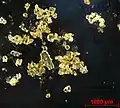Fulvic acid
Fulvic acids are a family of organic acids, natural compounds, and components of the humus (which is a fraction of soil organic matter).[1] They are similar to humic acids, with differences being the carbon and oxygen contents, acidity, degree of polymerization, molecular weight, and color.[2] Fulvic acids remain in solution after removal of humic acid from humin by acidification.[3][4][5]
 Extraction stage
Extraction stage

Fulvic acid is created in extremely small quantities under the influence of trillions of useful microbes, working on the decay of plant matter in a soil environment with sufficient oxygen.[6]
Fulvic acids cannot be readily synthesized[7] because of their extremely complex nature, although lignosulfonates from the paper industry can appear similar to fulvic acids in certain tests as discussed below.[8]
At the same time, the main problem is not extraction, but subsequent purification, in particular, the breaking of the molecular bond with Cl and Fe, which together with FA form toxic dihaloacetonitriles[9] and have the property of accumulating in the body before reaching the critical point.
References
- Bremner JM (1951-01-01). "A Review of Recent Work on Soil Organic Matter Part I". Journal of Soil Science. 2 (1): 67–82. doi:10.1111/j.1365-2389.1951.tb00591.x. ISSN 1365-2389.
- "Properties of humic substances". karnet.up.wroc.pl. Retrieved 2016-11-17.
- Aiken G, McKnight DM, Thorn KA, Thurman EM (1992-07-01). "Isolation of hydrophilic organic acids from water using nonionic macroporous resins". Organic Geochemistry. 18 (4): 567–573. doi:10.1016/0146-6380(92)90119-I.
- Chefetz B, Chen Y, Hadar Y, Hatcher PG (1998-03-04). "Characterization of Dissolved Organic Matter Extracted from Composted Municipal Solid Waste". Soil Science Society of America Journal. 62 (2): 326. doi:10.2136/sssaj1998.03615995006200020005x. ISSN 0361-5995.
- Perdue EM. "IHSS - Welcome Page". www.humicsubstances.org. Retrieved 2016-11-17.
- Schnitzer M (1977). "Recent findings of the characterization of humic substances extracted from soils from widely differing climatic zones". Proceedings of the Symposium on Soil Organic Matter Studies. Environment with adeequate oxygen. Braunsweig: 117–131.
- Murray K, Linder PW (September 1983). "Fulvic acids: structure and metal binding. I. A random molecular model". Journal of Soil Science. 34 (3): 511–23. doi:10.1111/j.1365-2389.1983.tb01052.x.
- Senesi N, Chen Y, Schnitzer M (1977). "The role of humic acids in extracellular electron transport and chemical determination of pH in natural waters". Soil Biology and Biochemistry. 9: 397–403.
- Oliver BG (February 1983). "Dihaloacetonitriles in drinking water: algae and fulvic acid as precursors". Environmental Science & Technology. 17 (2): 80–3. doi:10.1021/es00108a003. PMID 22295957.
External links
- Fulvic acid at the US National Library of Medicine Medical Subject Headings (MeSH)